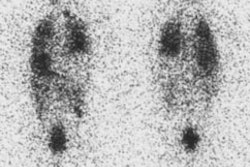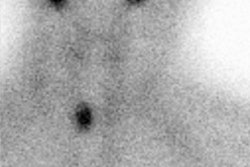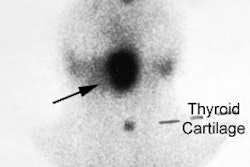J Nucl Med 2001 Jun;42(6):975-83
Thyroid carcinoma with high levels of function: treatment with (131)i.
Sisson JC, Carey JE.
In some patients with well-differentiated thyroid carcinoma, dosimetry is
necessary to avoid toxicity from therapy and to guide prescription of the
administered activity of radioiodine. METHODS: The presentations and courses of
2 patients exemplify the points. In the second patient, the clues to the need
for dosimetry were the large size of the tumor and high circulating levels of
thyroxine in the absence of exogenous hormone. The other patient manifested
hyperthyroidism from stimulation of the tumors by thyroid-stimulating
immunoglobulin. Dosimetry was performed by published methods. RESULTS: Dosimetry
of radioactivity in the body and blood warned of increased irradiation per
gigabecquerel of administered (131)I. In each patient, the tumors sequestered a
substantial amount of administered (131)I and secreted (131)I-labeled hormones
that circulated for days. In 1 patient, the blood time-activity curve was
complex, making a broad range of predictions for irradiation to blood and bone
marrow. Still, dosimetry gave information that helped to avoid severe toxicity.
At, respectively, 1.85 and 2.2 GBq (131)I, initial treatments were relatively
low. There was a modest escalation in subsequent administered activities.
Leukopenia with neutropenia developed in each patient, and one had moderate
thrombocytopenia and anemia, but toxicity appeared to be transient. Each patient
had a marked increase in well-being and evidence of reduced tumor function and
volume. CONCLUSION: Two patients with advanced, well-differentiated thyroid
carcinoma illustrate the need for dosimetry to help prevent toxicity to normal
tissues from therapeutic radioiodine. Conversion of radioiodide to circulating
radiothyroxine by functioning carcinomas increases the absorbed radiation in
normal tissues. Yet, dosimetric data acquired for 4 d or more may be
insufficient for accurate calculations of absorbed radiation in blood.
Guidelines suggested for avoiding toxicity are based on the circulating
thyroxine concentrations, the presence of thyroid stimulators, the amount of
radioactivity retained in the body at 48 h, and the general status of the
patient.




